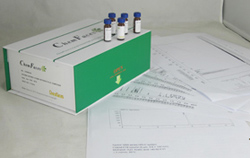Hot Products



| Catalog No. | Information |
| CFN90175 | Neogambogic acid Neogambogic acid , an active ingredient in garcinia, can inhibit the growth of some solid tumors and result in an anticancer effect, it may be responsible for the inhibition of proliferation of human breast cancer cell line MCF-7 cells. |
| CFN00503 | Neoglucobrassicin |
| CFN90792 | Neoglycyrol Neoglycyrol shows some cardioprotective effects . |
| CFN89242 | Neogrifolin Neogrifolin is a potential candidate for osteosarcoma, it can induce concentration- and time-dependent suppression of proliferation and induce apoptosis in U2OS and MG63 osteosarcoma cell lines; it exhibits inhibitory activity against nitric oxide (NO) production stimulated by lipopolysaccharide (LPS) in RAW 264.7 cells with the IC50value of 23.3 microM. Neogrifolin possesses antimicrobial activities against Bacillus cereus and Enterococcus faecalis, the MIC values of 20 and 0.5 microg/mL, respectively. |
| CFN99125 | Neohesperidin Neohesperidin, a natural new nutrition sweetener, has antioxidant (IC50=22.31ug/mL), anti-inflammatory, and neuroprotective effects. It can attenuate cerebral ischemia-reperfusion injury via the inhibition of neuronal and oxidative stress through the regulation of the apoptotic pathway and activating the Akt/Nrf2/HO-1 pathway, it may be useful for the treatment and/or protection of gastritis. |
| CFN90867 | Neoisoastilbin Neoisoastilbin may have antioxidant and anti-inflammatory activities. |
| CFN90823 | Neoisoliquiritin Neoisoliquiritin is a natural product from Glycyrrhiza uralensis. |
| CFN91802 | Neolancerin Neolancerin is a natural product with weak cytotoxic activity against HL-60 cells. |
| CFN96373 | Neoliquiritin Standard reference |
| CFN98122 | Neomangiferin Neomangiferin exhibits antidiabetic and antiosteoporotic actions; it has beneficial effects on high fat diet-induced nonalcoholic fatty liver disease in rats, it also modulates the Th17/Treg balance and ameliorates colitis in mice. |